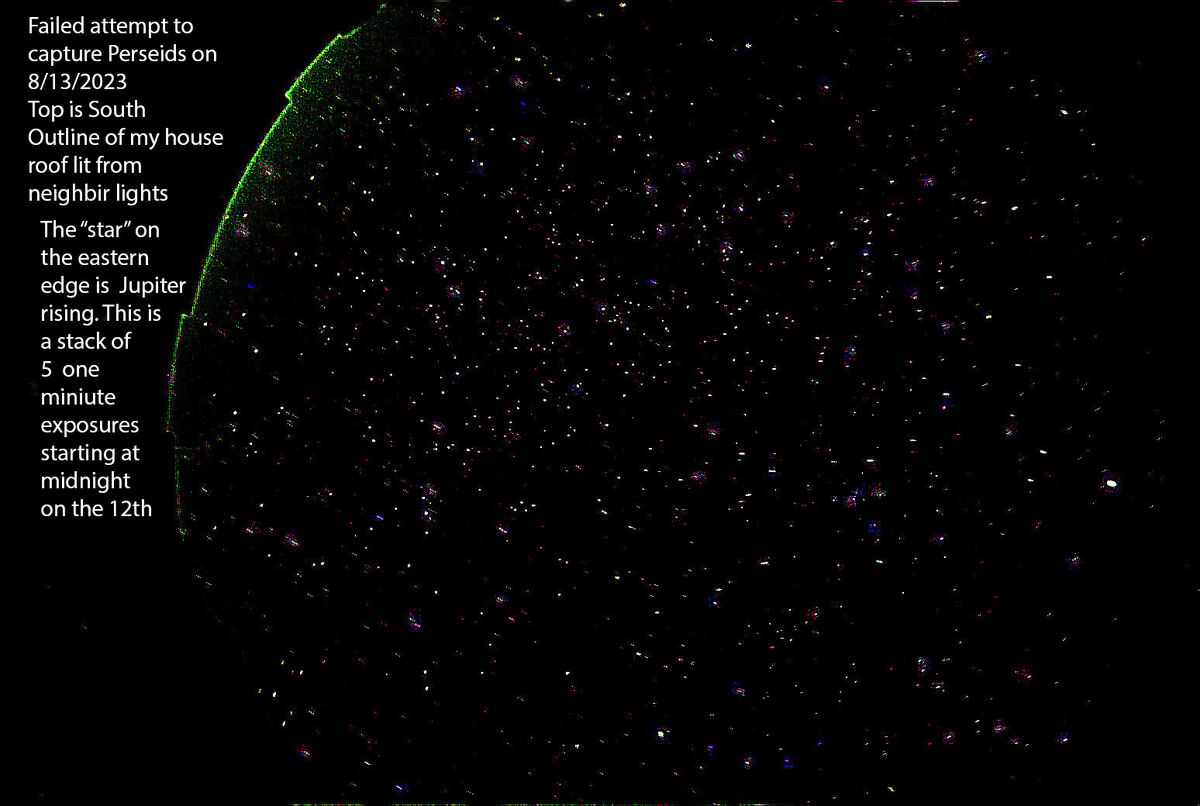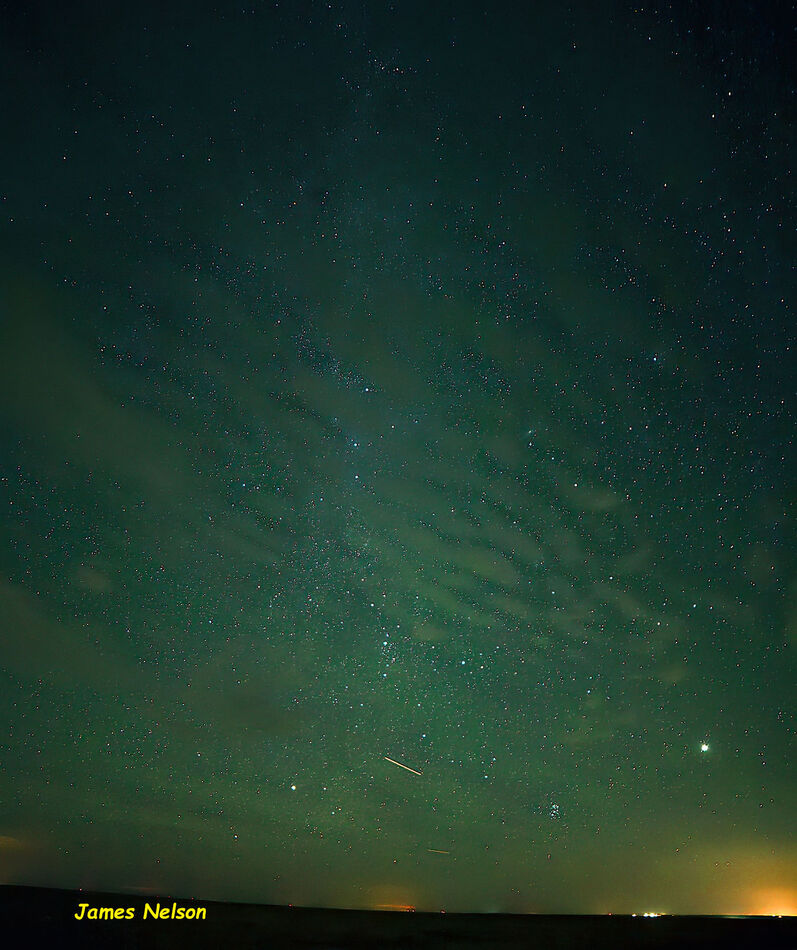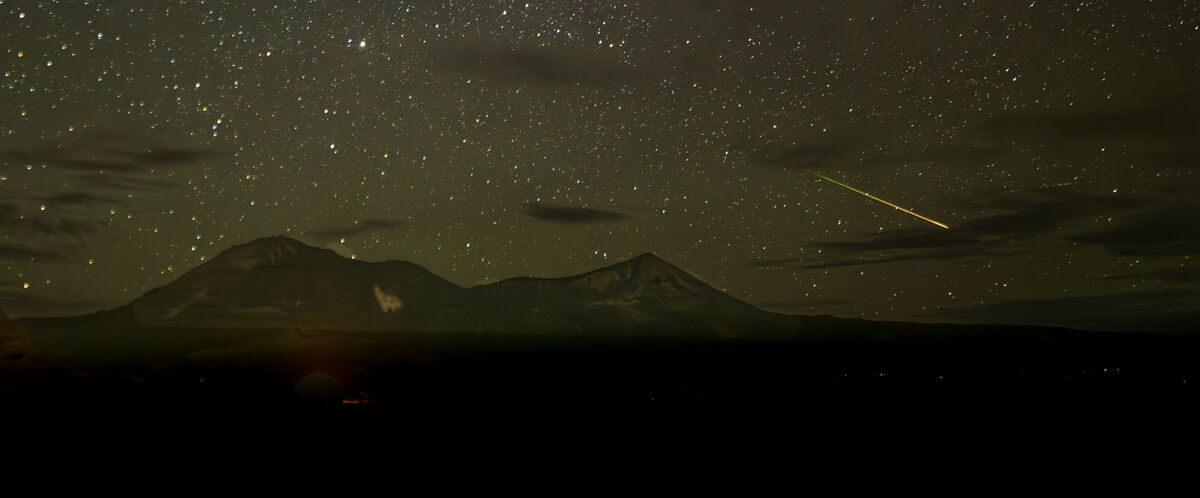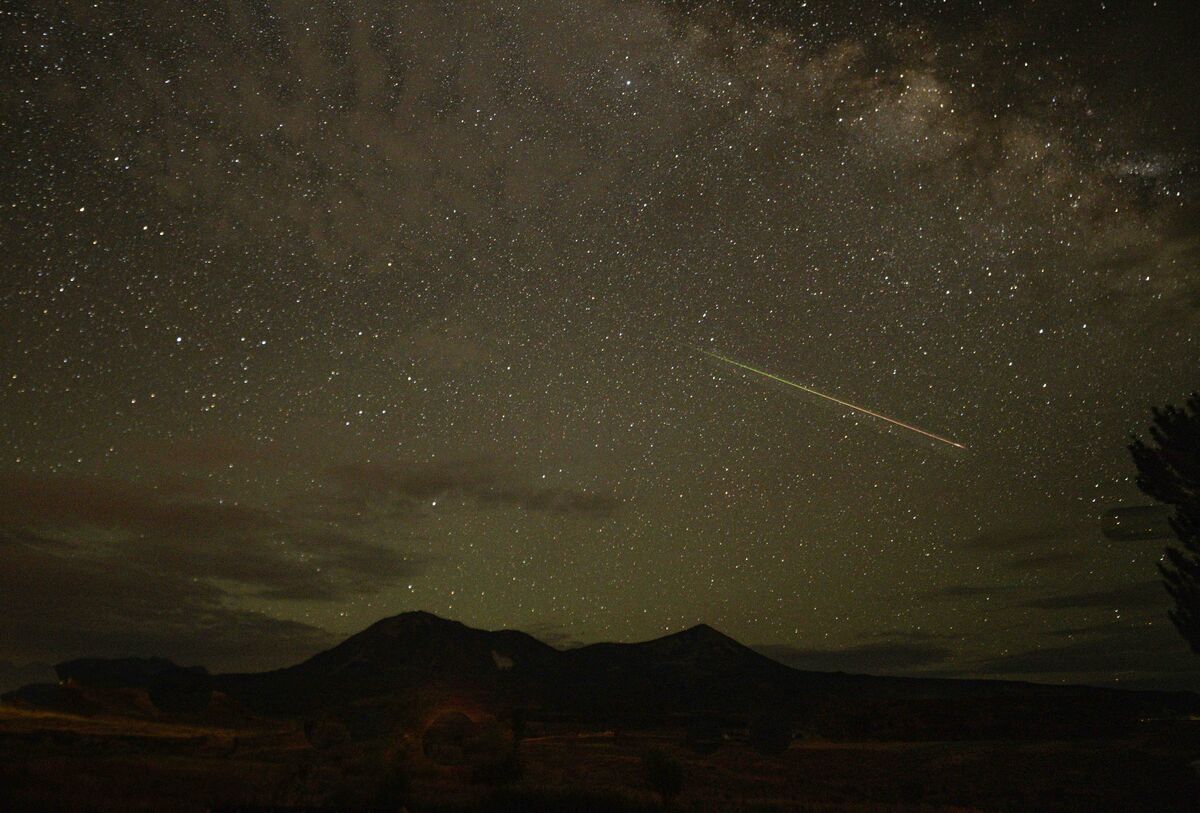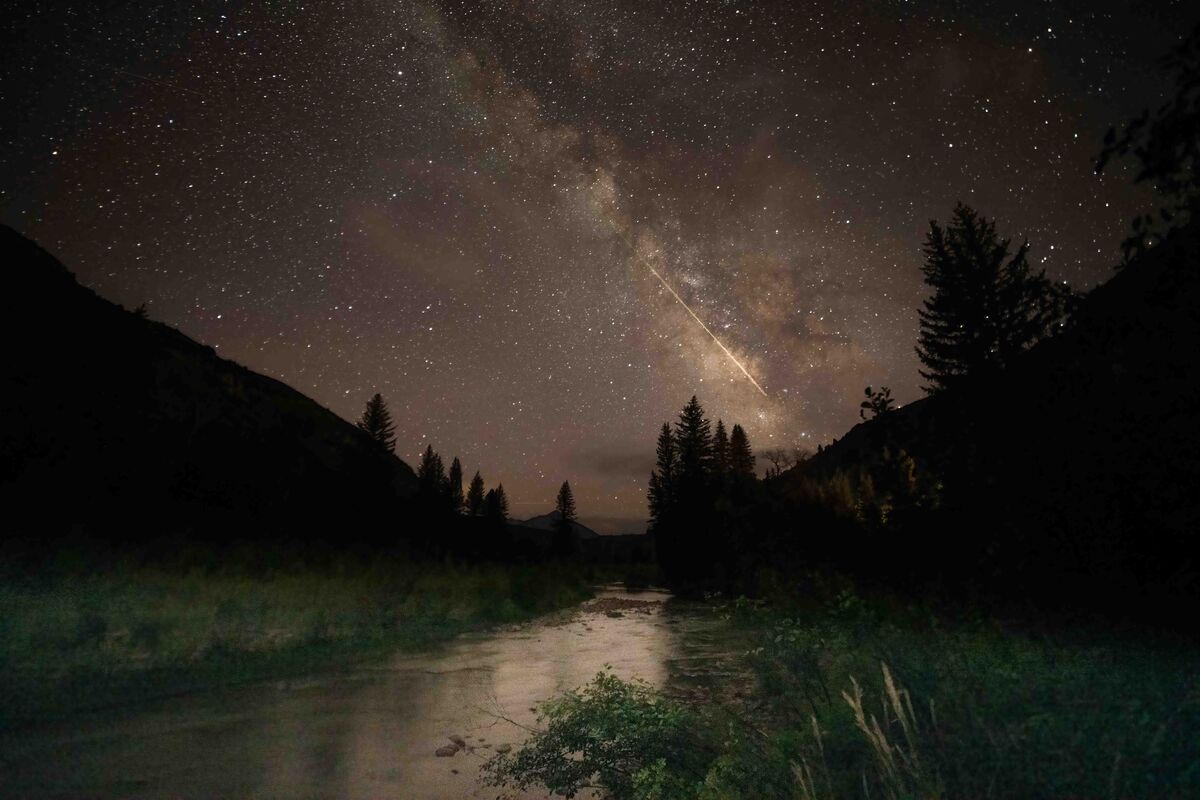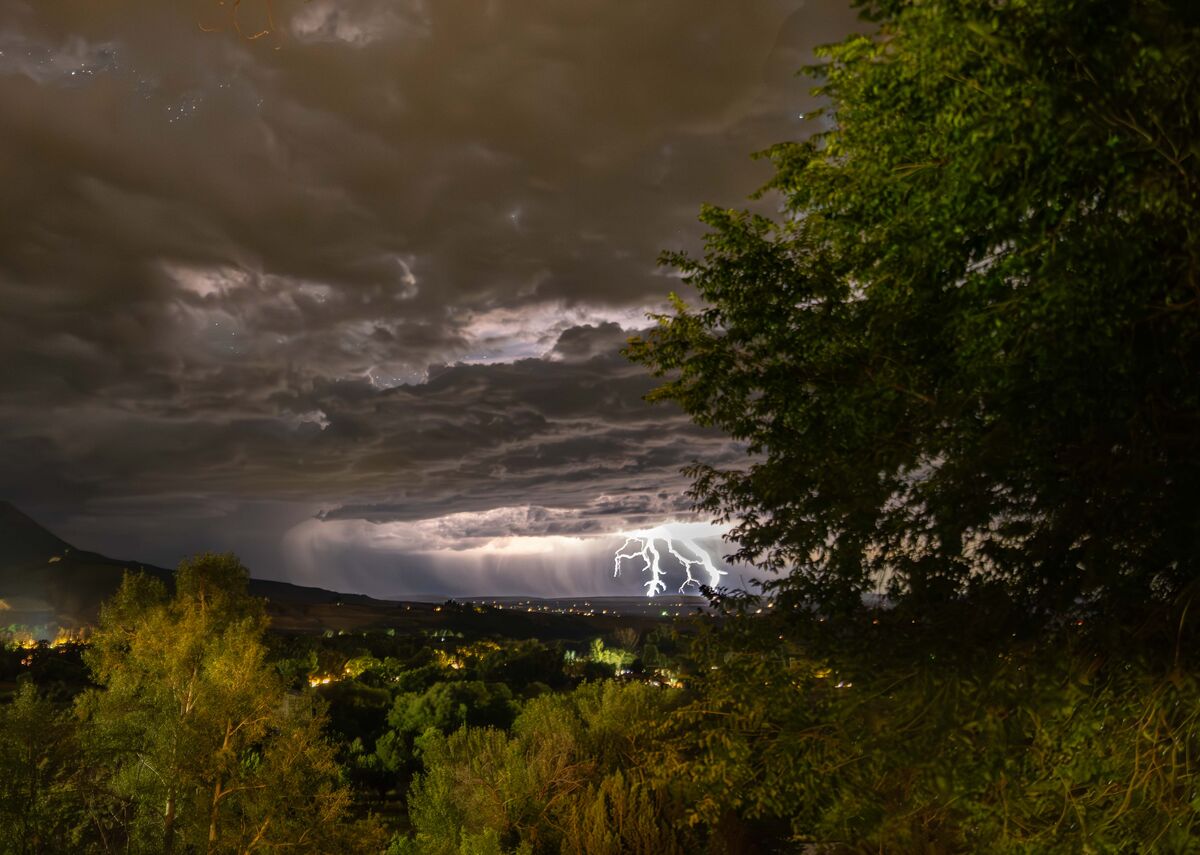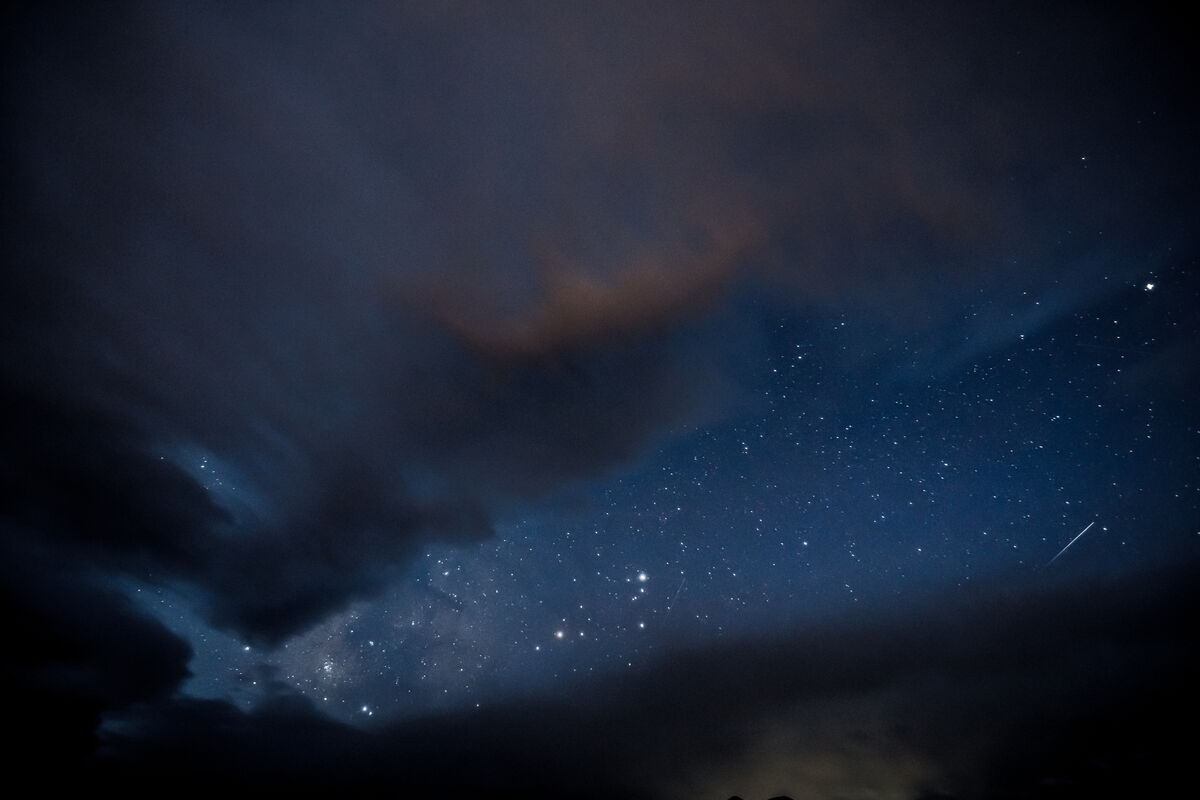Perseids Meteor Shower - FAIL!!
Aug 19, 2023 15:52:00 #
I attempted to use my ZWO ASI178MC camera with its "all sky" fisheye lenses to capture the Perseids meteor shower. I set the camera to capture 180 1-minute exposures which would give me 3 hours of observation time. I placed the camera on top of a tall step ladder to eliminate ground clutter, started the exposures, leaned back in my reclining swing and watched a beautiful night sky. I saw 6 bright meteors pass almost directly above me, so I knew I had something good on the camera.
I did not have a single one. I stacked various intervals of exposures, forced exposure, curves, etc all over the place, and found not even a light trace. I am attaching the camera settings and one of the ugly stacks of 5 1-minute exposures taken at midnight. There should be 2 bright meteors on this picture - but ther t'a'int! I am also attaching the camera settings text with the picture.
ANY AND ALL SUGGESTIONS as how to fix it to get real pictures next time are . . . begged for!!!! I want to be ready for the next shower!
Well , I couldn't get it to attach the text file so here is the camera text stuff:
[ZWO ASI178MC]
FrameType=Light
Pan=0
Tilt=0
Output Format=JPEG files (*.jpg)
Binning=2
Capture Area=3096x2080
Colour Space=RGB24
Temperature=38.1
Hardware Binning=Off
High Speed Mode=Off
Turbo USB=40
Flip=None
Frame Rate Limit=Maximum
Gain=31
Exposure=60.000s
Timestamp Frames=Off
White Bal (B)=50
White Bal (R)=50
Brightness=340
Auto Exp Max Gain=255
Auto Exp Max Exp M S=100
Auto Exp Target Brightness=100
Mono Bin=Off
Trail Width=3
Minimum Trail Length=100
Trail Detection Sensitivity=9
Remove Satellite Trails=Off
Background Subtraction=Off
Planet/Disk Stabilization=Off
Banding Threshold=10
Banding Suppression=0
Apply Flat=None
Hot Pixel Sensitivity=5
Subtract Dark=None
NegativeDisplay=0
Display Black Point=0.101190476190476
Display MidTone Point=0.602114121510672
Display White Point=0.857142857142857
Notes=
TimeStamp=2023-08-13T06:34:38.6309757Z
SharpCapVersion=4.0.9538.0
StartCapture=2023-08-13T06:33:39.2425035Z
MidCapture=2023-08-13T07:25:38.6195035Z
EndCapture=2023-08-13T08:17:37.9961285Z
Duration=6238.754s
FrameCount=102
ActualFrameRate=0.0163fps
TimeZone=-7.00
I did not have a single one. I stacked various intervals of exposures, forced exposure, curves, etc all over the place, and found not even a light trace. I am attaching the camera settings and one of the ugly stacks of 5 1-minute exposures taken at midnight. There should be 2 bright meteors on this picture - but ther t'a'int! I am also attaching the camera settings text with the picture.
ANY AND ALL SUGGESTIONS as how to fix it to get real pictures next time are . . . begged for!!!! I want to be ready for the next shower!
Well , I couldn't get it to attach the text file so here is the camera text stuff:
[ZWO ASI178MC]
FrameType=Light
Pan=0
Tilt=0
Output Format=JPEG files (*.jpg)
Binning=2
Capture Area=3096x2080
Colour Space=RGB24
Temperature=38.1
Hardware Binning=Off
High Speed Mode=Off
Turbo USB=40
Flip=None
Frame Rate Limit=Maximum
Gain=31
Exposure=60.000s
Timestamp Frames=Off
White Bal (B)=50
White Bal (R)=50
Brightness=340
Auto Exp Max Gain=255
Auto Exp Max Exp M S=100
Auto Exp Target Brightness=100
Mono Bin=Off
Trail Width=3
Minimum Trail Length=100
Trail Detection Sensitivity=9
Remove Satellite Trails=Off
Background Subtraction=Off
Planet/Disk Stabilization=Off
Banding Threshold=10
Banding Suppression=0
Apply Flat=None
Hot Pixel Sensitivity=5
Subtract Dark=None
NegativeDisplay=0
Display Black Point=0.101190476190476
Display MidTone Point=0.602114121510672
Display White Point=0.857142857142857
Notes=
TimeStamp=2023-08-13T06:34:38.6309757Z
SharpCapVersion=4.0.9538.0
StartCapture=2023-08-13T06:33:39.2425035Z
MidCapture=2023-08-13T07:25:38.6195035Z
EndCapture=2023-08-13T08:17:37.9961285Z
Duration=6238.754s
FrameCount=102
ActualFrameRate=0.0163fps
TimeZone=-7.00
Aug 19, 2023 15:54:21 #
Aug 19, 2023 21:17:09 #
PoppieJ
Loc: North Georgia
i don't know how far north you are but I am in the southeastern US and all of my Perseids meteor streaks are close to the horizon. the next one up with a dark sky the geminids (Dec 17?) will be high in the sky to the southeast
Aug 20, 2023 16:38:24 #
I spent last Saturday night trying to elude the clouds. I then spent another 1 1/2 hours shooting the sky. I saw many meteors all over the sky but very few in front of my lens I was shooting 20 second exposures at ISO 3200 at f2.8 using a Canon R and a Rokinon 14 mm lens. You can see some clouds were present. The short streak near bottom center was the only image I got. I was about 60 miles northeast of Denver outside of Ft Morgan, CO.
Aug 20, 2023 22:21:38 #
What I am about to say is just some wild ass might be's. I had the same experience several yrs ago using a Canon camera, nothing. Some thoughts, if you have five shots, the meteor would only be in one, might the stacking software throw it out as a bad image? I know such software has options for keeping best X%. I have also had either meteor or satellite streaks disappear during the course of live stacking, they just get diluted out until they disappear. Could something similar happen over the course of a long exposure for something only there for a short time, meteor, due to adjustments made by some camera setting.
I read a lot, but have done little, so what I say may well be nonsense, but even idiots can get lucky.
At work, 4 or 5 PhD scientists were trying to make slides from PowerPoint using a device which actually photographed a small screen in an enclosed box. The images were cock eyed, something that had never happened. They keep trying and discussing, but no solution. Being a smartass, I said maybe "the cameras on cock eyed". BINGO!!! None of us had ever considered how the images got to film, we all just used it. It was a magic black box.
Good luck;
were in
I read a lot, but have done little, so what I say may well be nonsense, but even idiots can get lucky.
At work, 4 or 5 PhD scientists were trying to make slides from PowerPoint using a device which actually photographed a small screen in an enclosed box. The images were cock eyed, something that had never happened. They keep trying and discussing, but no solution. Being a smartass, I said maybe "the cameras on cock eyed". BINGO!!! None of us had ever considered how the images got to film, we all just used it. It was a magic black box.
Good luck;
were in
Aug 21, 2023 12:59:32 #
mrtkarlin
Loc: Ashland, Oregon
Every year is a new thrill. This was a good one, no clouds, no moon, a goodly number of meteors, and great settings. Many meteors to the east and southeast, both lower and higher in the sky. Mostly shot between 9:30pm and 1:00am Night one was in Paonia, CO. Night two was on the N Fork of the Gunnison near Paonia Reservoir. The river was lined up with the Milky Way. That was fortuitous. Night three was again in Paonia, but the feature was clouds and lightning, not as crisp as I would like, but dramatic. All were shot with a Z9, 14mm Rokinon, with the same settings as mojaveflyer - 20 sec, ISO 3200, f2.4. Post processing was in Lightroom. Masked the sky and foreground separately. I have another 20 or 30 pictures that I will stack when I have some time.
Marty
mrtk.smugmug.com
Marty
mrtk.smugmug.com
Aug 23, 2023 17:23:15 #
W7MEV wrote:
I attempted to use my ZWO ASI178MC camera with its... (show quote)
My non-technical advice is to try the Lyrids in April. I've shot both the Perseids and the Lyrids several times, and I've always caught far more meteors during the Lyrids. Brighter ones, too.
My tech advice is to shoot with a narrower view. With a fisheye, you'll notice only the brightest of the bright meteors. Also, you might not notice any in a RAW file, so rough batch-processing your shots to brighten them will help you when you scan them for meteors.
As I've sat watching the stars and daydreaming while letting my camera snap pic after ~20-second pic, I sometimes made note of any meteors I saw, jotting down the approximate time to make sure I wouldn't overlook them later when looking through hundreds of images.
And finally, shooting meteors is like fishing. You should've seen the one that got away. I'll never forget the intensely bright flash above me while I was setting up one night. Had I been just five minutes earlier...
I'll attach the only meteor image I have handy, one of my favorites I caught near dawn on a bad night. The sky was on-and-off overcast, but I let my camera keep shooting since I was already out there and set up. A break in the clouds caught a bright Lyrid on the right and with the Milky Way's core on the left. Notice it's streaking upward, as they do shortly before dawn.
Aug 28, 2023 16:55:00 #
I only have my first attempt at Joshua Tree National Park in 2015.
https://youtu.be/O5hf0szmKVE?si=okehiOwsOqixUV7j
IIRC, I was shooting two or three fames a minute, 25 or ~20 seconds each. I set so there was download/storage time, and some time for the shutter to reset before the following shot.
I'd suggest you try making some star trails. Or do some time lapses of the Super Moon this week.
The old adage, "Practice Makes Perfect" applies. It really is a lot of fun.
I use Windows Movie Maker to put the images together.
If you'd like, StarTrails is another program.
https://youtu.be/O5hf0szmKVE?si=okehiOwsOqixUV7j
IIRC, I was shooting two or three fames a minute, 25 or ~20 seconds each. I set so there was download/storage time, and some time for the shutter to reset before the following shot.
I'd suggest you try making some star trails. Or do some time lapses of the Super Moon this week.
The old adage, "Practice Makes Perfect" applies. It really is a lot of fun.
I use Windows Movie Maker to put the images together.
If you'd like, StarTrails is another program.
If you want to reply, then register here. Registration is free and your account is created instantly, so you can post right away.
